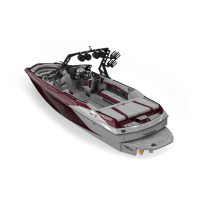Preparing to ski or ride: Always have a person other than the driver act as an observer to look
out for the skier/rider.
• Be sure the driver is aware of the experience and ability of the skier/rider.
• The driver, observer and skier/rider need to agree on hand signals before skiing or riding.
Signals should include READY, STOP, SPEED UP and SLOW DOWN.
• Start the engine only after making sure that no one in the water is near the propeller.
• Turntheengineowhenpeoplearegettingintooroutofthewatercraft,orinthewaternear
the watercraft.
• Always make sure the tow rope is not wrapped around anyone’s hands, arms, legs or other
parts of the body.
• Start the watercraft and move slowly to remove slack until the tow rope is tight.
• Whentheskier/ridersignalsREADYandthereisnotraicahead,takeoinastraightline.
Adjust the speed according to the signals given by the skier/rider.
Skiing or Riding: Thewatercraftandskier/ridershouldalwaysmaintainasuicientdistancefrom
obstacles so a skier/rider falling or coasting and/or watercraft will not encounter any obstacle.
• Do not use in shallow water or near shore, docks, pilings, swimmers, other watercraft, or any
other obstacles.
• Use only on water.
• Never attempt land or dock starts. This will increase your risk of injury or death.
• Alwayswearaproperlyttedlifejacket(PFD)approvedbyyourcountry’sagency,USCGType
III, ISO, etc.
• The faster you ski or ride, the greater your risk of injury.
• Nevermakesharpturnsthatmaycauseaslingshoteectontheskier/rider’sspeed.
• The skier/rider should be towed at an appropriate speed for his or her ability level.
Faller skier or rider:Fallingandinjuriesarecommoninskiingorriding.
• Circleafallenskier/riderslowlytoreturnthetowropehandleorpickupthefallenskier/rider.
• Turnotheenginewhennearafallenskier/rider.
• Always keep the fallen skier/rider in view and on the driver’s side of the watercraft.
Axis
Owners
Manual
2019
Page 41

